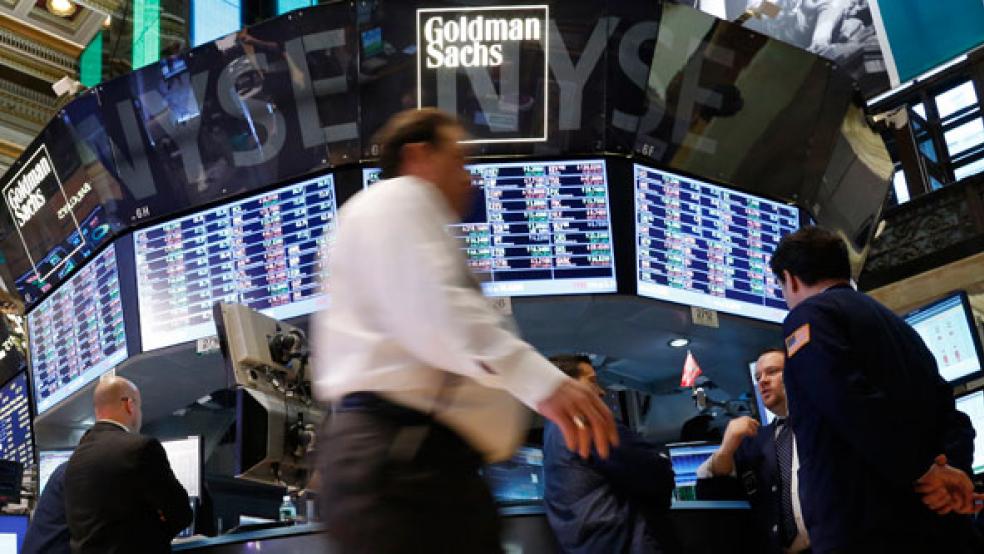For big banks so far this earnings season, the more investment banking they do, the better. There’s no stronger example of this than the world’s premiere investment bank, Goldman Sachs (NYSE: GS). For the first quarter, Goldman on Tuesday reported revenues of $10.09 billion and net income of $2.26 billion for earnings per share of $4.29, all beating expectations.
On a conference call with analysts and reporters, Goldman CEO Lloyd Blankfein noted that “the potential for macroeconomic instability was felt in the quarter and constrained overall corporate and investor activity,” but CFO Harvey Schwartz described it as “overall, a solid result.”

The big banks that have reported earnings so far – JPMorgan Chase (NYSE: JPM), Wells Fargo (NYSE: WFC), Citigroup (NYSE: C) and Goldman – have all posted “solid” or better results for the first three months of the year, but some differences in how they achieved those results matter.
While JPMorgan Chase managed to report high net income on declining revenue because of substantial releases from litigation reserves and lower expenses, Goldman’s revenue increased 9 percent from the fourth quarter of 2012 on substantial gains in the most traditional investment banking business: equity and debt issuance, which brought in $1.08 billion.
Investment banking revenue overall came in at $1.57 billion, a 36 percent jump over the year and 12 percent from last quarter. According to Bloomberg, Goldman Sachs beat JPMorgan’s quarterly investment banking revenue, $1.43 billion this quarter, for the first time in five years. As part of those gains, Goldman set a record in quarterly revenue from debt underwriting with some $694 million. Revenue from debt and equity underwriting were up 53 and 59 percent respectively from a year ago, and Schwartz said on the analyst call that “corporate issuers took advantage of low interest rate environment and strong investor demand.”
Schwartz said that Goldman was benefitting from a market cycle, where clients were coming back to the bank to refinance. The Financial Times reported last week that 69 percent of all junk-bond issuance this year was to refinance existing debt.
That frothiness in debt issuance is due to rock-bottom interest rates in major economies, especially the United States. While rates are largely low because of the weak economy, pushing rates down is also a deliberate policy on the part of the Federal Reserve.
The low interest rate environment has fueled an appetite for increased yield wherever it can be found – including in junk, or high-yield, bonds. Federal Reserve Governor Jeremy Stein acknowledged in a February speech that, “We are seeing a fairly significant pattern of reaching-for-yield behavior emerging in corporate credit.”
Banks like Goldman help companies feed that demand. At a conference in December, Blankfein said that Goldman was advising its corporate clients to take advantage of the low interest-rate environment and borrow "as much as they're going to need for as long as they think they could need it." At the same time, Blankfein raised the prospect that investors who buy the bonds those companies are issuing could face significant future losses. "What's going to happen when growth picks up and interest rates rise?” Blankfein asked. “There's going to be a reversal and people will have losses." He also described interest rates rising as “one of the big risks that are looming out there right now.”
So Goldman is making record revenues underwriting bonds with historically low rates (and, thus, high prices) and has encouraged its clients to take on debt, but it has reduced its own exposure to losses from a jump in interest rates. The bank’s value-at-risk, meaning the maximum potential losses in a single day at a 95 percent confidence level, was $76 billion, unchanged from last quarter and $19 billion less than a year ago because of lower volatility. The value at risk for interest rates fell to $62 billion from $67 billion. In the first quarter of last year, interest rate VAR was $90 billion.
Even with the gains in debt and equity underwriting, the lion share of the bank’s revenue, some $5.1 billion, still came from sales, trading, and security services for clients. Goldman had just over $2 billion in revenue on its own loans and investments, as opposed to those it makes for clients – the highest mark in two years according to Bloomberg. Schwartz said that these gains, 5 percent from the previous quarter and 8 percent from the first quarter of 2012, “primarily reflect gains from private equity investments.” Goldman’s revenue from asset management was $1.3 billion, 12 percent higher than from a year ago but 13 percent lower than last quarter.




